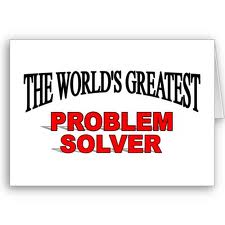Embrace an Entirely New Business Leadership Style.
“My, What Big Business Plans You Have Grandma.”
I have been thinking (and writing) a lot lately about ways that entrepreneurs, start-ups and business owners can improve their business (go from good to great) by practicing exceptional business leadership skills. To transform your business, now is the perfect time to go back to your start-up roots and rekindle the passion you had when you first launched your business. Go “old school” to revisit the time-tested to grow a successful business that you may have gotten away from in the hustle and bustle of operating your business.
You can’t get any more “old school” then asking: “What would grandma do to transform my business if I put her in charge for just one day?
Embrace the Art of Gift-giving: Grandma would come to the office with gifts. Did you ever bake and bring in a homemade apple pie (yum, pie!) for your employees? Did you ever knit a sweater to celebrate an employee’s birthday, or a special accomplishment? Grandma always knew how to welcome people in her home with open arms. She made us feel special, wanted, and appreciated! How do you make your employees, clients, vendors and partners all feel special, like grandma?
Do you make your newly hired employees feel good about joining your team? Do you welcome each and every one of your new hires? I’m not talking about shaking their hand as you lead them to their cubicle (cage) but MUCH more. Do you take them out for breakfast their first day on the job?? How about taking the time to walk them around and introduce them to everyone? Do you check in with them in the middle and end of their first day on the job, to see how they are doing? Do you ask new employees what their experiences were like their first day on the job?

Hug Your Employees: We’re not talking about physically hugging. In today’s politically correct business culture that would mean opening yourself up to a sexual harassment claim. Do you emotionally embrace your people, make them feel good about you as their leader? After all, your people spend more time at your place of business then they do in their own homes. Show them how much you appreciate them. Grandma cooked us our favorite meals. You can certainly reward, recognize, coach, mentor, and promote people. Give people increased responsibilities. Make all your employees feel equally special. DON’T pull a grandma and show favoritism to that one most favored grandchild. In the grandparent business, it’s called providing unconditional love. In best business practices, it’s called visionary business leadership.
Love Your Family Unconditionally: Your people are going to make mistakes. Instead of punishing them, follow grandma’s lead. Encourage them to be their best, take risks, embrace the discomfort of tackling the unknown. challenge them to fail greatly. Grandma would go even farther. She would get to know their hopes and fears, talk to them often about the very real challenges they face in balancing their home and work life. Lend a shoulder to lean on, and provide an ear to bend as you truly LISTEN.
Sit Up Straight, Make Eye Contact, and Behave: Grandma would provide much-needed executive coaching and professional development best practices to your management team. She’d start by telling you to stop slouching, sit up straight and make eye contact! Be proud of who you are and your accomplishments “deary” and always look others square in the eyes so they can trust you.

Grandma would remind you that your word is a promise, and trust is absolutely critical not only in business, but in life. She would then lecture you (lovingly) about how we could all do with a bit more trust in one another these days. She’d also add that it’s important to say “please” and “thank you.” She’d also remind us the business world wouldn’t have had to deal with Bernie Madoff, Enron, Adelphia, Global Crossing, Halliburton, British Petroleum, etc. if more of us business owners acted with the highest ethical standards. She would pinch your cheek and suggest that the most profitable businesses operate in the highest ethical standards and true leaders take their business along a course guided with a strong moral compass you summarized as “DO GOOD.”
No Pink Slips, Just Pink Booties: Grandmas don’t fire, layoff, right-size, down-size, re-engineer, off-shore, or outsource their people…ever! Once they bring you into the family, you’re family. If an employee was valuable enough to bring into your organization, then they should always be able to contribute especially if you develop them professionally. Every grandma know that! They don’t believe in pink slips, but they may just knit your infant a pair of pink booties.
Understand the Value of a Dollar: Grandma survived the Great Depression. Could you? Manage your business finances with a militant view towards keeping your debt down. Watch your cash flow and manage your business expenses. Take advantage of limited time free offers, make purchases using bonus points, take advantage of promotional offers, and use coupons. Have you ever heard the phrase: “Watch your pennies and the dollars will take care of themselves?” That’s a grandmother speaker. They also like to say: “penny wise, pound foolish.” That means NOT cutting back on the expenses needed to take care of your people. In fact, a grandma would know it makes brilliant business sense to spend money for special gifts on your employees to make them feel special and appreciated.
Conflict Resolution With Fresh-Baked Cookies: If two co-workers aren’t getting along, Grandma would make them sit together and work through their issues over her freshly baked cookies and home made hot cocoa. Honestly, how could ANYONE stay angry after enjoying piping hot chocolate chip cookies served with steamy homemade hot cocoa (and whipped cream?)
Well, the workday is winding down and Grandma’s work is done. Your people are happier than ever, your customers feel a lot better about you and your business, and things are humming along. Grandma would love to stay, but she has to get home to watch Wheel of Fortune and Skype with her grandson, who just left for his first year of college.
She’s turning your business back over to you, and ask you when you are coming to visit. You tell her “soon grandma” but first you have to plan employee appreciation luncheons, client roadshows, a town hall meeting, and find worthwhile causes for you and your employees to get active in. Watching her treat people the way she does all day long really affected you. You promise her you’ll change as a business owner. She just smiles, pats you on the cheek and says: “of course you will.” Because that’s what grandmas do.
Here’s to your continued business success.


















